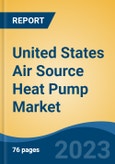Speak directly to the analyst to clarify any post sales queries you may have.
10% Free customizationThis report comes with 10% free customization, enabling you to add data that meets your specific business needs.
Technological advancements have improved system performance, making them viable even in colder climates. Additionally, growing construction activities and the push for electrification in the HVAC sector are further accelerating market expansion. The market is also benefiting from consumers' preference for sustainable alternatives to traditional fossil fuel-based heating systems. The National Association of Home Builders (NAHB) reports that over 70% of new single-family homes now include high-efficiency HVAC systems, such as air source heat pumps, to comply with IECC and ENERGY STAR standards.
Key Market Drivers
Rising Demand for Energy Efficiency and Reduced Carbon Emissions
One of the primary drivers of the United States air source heat pump (ASHP) market is the increasing demand for energy-efficient heating and cooling systems that help reduce carbon emissions. Traditional systems like gas furnaces and electric resistance heaters are energy-intensive and contribute significantly to greenhouse gas emissions. In contrast, ASHPs are highly energy-efficient, transferring heat rather than generating it, and can offer efficiency ratings of 300% or higher depending on conditions.According to the U.S. Environmental Protection Agency (EPA), switching to ENERGY STAR certified air source heat pumps can save homeowners up to 50% on annual heating and cooling energy bills. With growing consumer awareness about climate change and energy conservation, homeowners and businesses are actively seeking more sustainable alternatives. Air source heat pumps provide a low-carbon solution that supports the shift toward cleaner energy. They are particularly attractive for achieving net-zero goals and meeting energy codes such as the International Energy Conservation Code (IECC) and California’s Title 24. These regulations increasingly promote high-efficiency HVAC technologies, making ASHPs a preferred choice for both new construction and retrofits.
Key Market Challenges
High Initial Installation Costs
One of the most significant challenges limiting the widespread adoption of air source heat pumps in the United States is the high upfront installation cost. Compared to traditional HVAC systems such as gas furnaces or central air conditioning units, ASHPs generally involve greater expenses for both equipment and installation. These costs can vary depending on the size of the system, the complexity of installation, the need for electrical upgrades, and the condition of the existing ductwork or building infrastructure.For homeowners, especially those in low-to-middle-income brackets, the initial investment can be a barrier, despite the long-term energy savings ASHPs offer. Even with available federal and state incentives, the perception of heat pumps as expensive can deter potential buyers. For instance, retrofitting an older home may require additional modifications such as ductwork upgrades or electrical panel enhancements which increase the overall project cost.
Key Market Trends
Shift Toward Electrification and Decarbonization
One of the most significant trends driving the U.S. air source heat pump market is the nationwide shift toward building electrification and carbon reduction. As cities and states set ambitious climate goals to lower greenhouse gas (GHG) emissions, there is increasing pressure to phase out fossil fuel-based heating systems such as oil and natural gas furnaces. In this context, air source heat pumps powered by electricity and offering high efficiency are gaining traction as a key solution for sustainable heating and cooling.Municipalities like New York City, Seattle, and San Francisco have already implemented or proposed bans on natural gas connections in new residential and commercial buildings, further accelerating the move toward electric heating technologies. Heat pumps also align with broader “electrify everything” strategies, where energy systems are designed to run entirely on electricity sourced increasingly from renewables.
Key Market Players
- Daikin U.S. Corporation
- Carrier Corporation
- Rheem Manufacturing Company
- Trane US, Inc.
- Johnson Controls, Inc.
- Lennox International Inc.
- Bosch Thermotechnology Corp.
- Emerson Electric Co.
- GE Appliances
- Stiebel Eltron, Inc.
Report Scope:
In this report, the United States Air Source Heat Pump Market has been segmented into the following categories, in addition to the industry trends which have also been detailed below:United States Air Source Heat Pump Market, By Process:
- Air to Air
- Air to Water
United States Air Source Heat Pump Market, By End Use:
- Residential
- Hotels & Resorts
- Gym & Spas
- Education
- Food Service
- Others
United States Air Source Heat Pump Market, By Sales Channel:
- Plumbers
- Dealers & Contractors
- Retail
- Direct Sales
- Online
- Others
United States Air Source Heat Pump Market, By Region:
- South
- West
- Midwest
- Northeast
Competitive Landscape
Company Profiles: Detailed analysis of the major companies present in the United States Air Source Heat Pump Market.Available Customizations:
With the given market data, the publisher offers customizations according to a company's specific needs. The following customization options are available for the report.Company Information
- Detailed analysis and profiling of additional market players (up to five).
This product will be delivered within 1-3 business days.
Table of Contents
Companies Mentioned
- Daikin U.S. Corporation
- Carrier Corporation
- Rheem Manufacturing Company
- Trane US, Inc.
- Johnson Controls, Inc.
- Lennox International Inc.
- Bosch Thermotechnology Corp.
- Emerson Electric Co.
- GE Appliances
- Stiebel Eltron, Inc.
Table Information
| Report Attribute | Details |
|---|---|
| No. of Pages | 81 |
| Published | September 2025 |
| Forecast Period | 2024 - 2030 |
| Estimated Market Value ( USD | $ 8.15 Billion |
| Forecasted Market Value ( USD | $ 13.69 Billion |
| Compound Annual Growth Rate | 9.0% |
| Regions Covered | United States |
| No. of Companies Mentioned | 10 |









